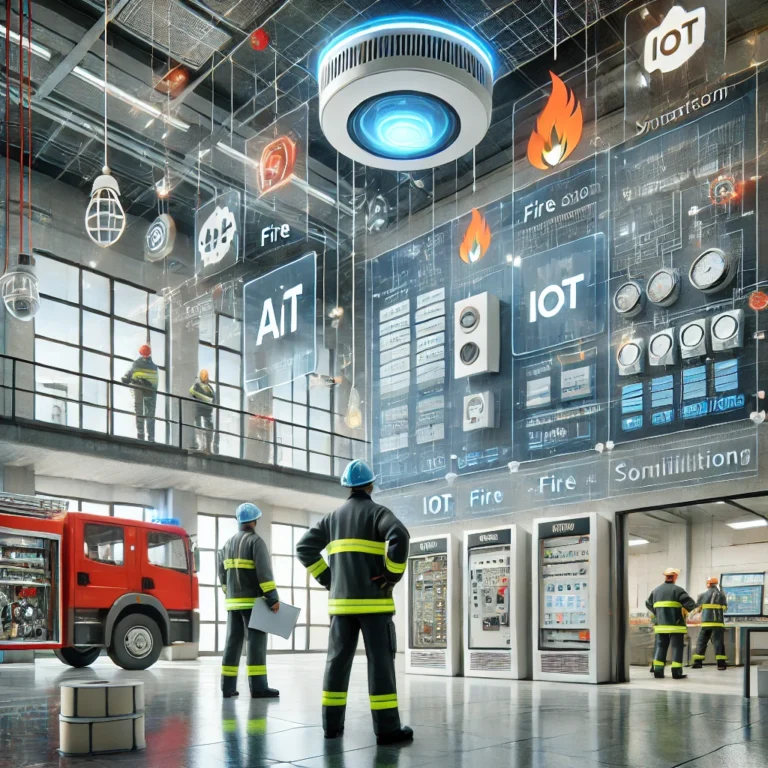Fire Safety Engineering: Innovations and Future Trends
Table of Contents
In the rapidly evolving field of fire protection system, new technologies and methodologies are enhancing how buildings are protected from fire hazards. Integrating advanced fire detection systems, innovative suppression technologies, and fire-resistant materials is transforming fire safety for residential, commercial, and industrial settings.
In this blog, we’ll explore the most recent advancements in fire safety engineering, highlighting the innovations that are shaping its future. Whether you’re involved in fire safety planning, building management, or just curious about how the industry is progressing, this guide will offer essential insights.
Key Innovations in Fire Safety Engineering
1. AI-Driven Fire Detection Systems
Artificial Intelligence (AI) is dramatically improving fire detection by enhancing accuracy and significantly reducing false alarms. AI-based fire detection systems analyze data from various sources—such as cameras and thermal sensors—to detect early signs of smoke and fire.
- How It Works: AI systems monitor real-time data streams and differentiate between legitimate fire hazards and non-threatening situations, like cooking smoke. As a result, this helps reduce unnecessary evacuations and ensures a faster, more accurate response.
- Benefits: Faster detection, fewer false alarms, and more effective emergency responses.
To learn more about AI in fire safety, visit NFPA’s latest research.
2. Smart Fire Suppression Technologies
Traditional fire suppression systems, such as sprinklers, are now being enhanced by smart fire suppression systems. These innovations use real-time data to release water or chemical suppressants only where necessary, avoiding widespread damage.
- Innovation: Smart suppression systems target the fire’s source instead of flooding an entire room. By integrating with building management systems, they respond more efficiently to the specific fire type and severity.
- Advantages: Minimized water damage, more efficient suppression, and reduced impact on unaffected areas.
Explore more about smart fire suppression technologies with the Fire Suppression System Association.
3. Fire-Resistant Building Materials
Developments in fire-resistant materials are significantly helping to slow down the spread of fire in modern buildings. These materials are crucial in high-rise buildings and industrial facilities, where fire hazards can have catastrophic consequences.
- Key Materials: Fire-resistant coatings, non-combustible composites, and heat-resistant steel structures are increasingly becoming standard in construction.
- Applications: Such materials maintain the structural integrity of buildings during fires, giving occupants more time to evacuate while preventing widespread damage.
For more information on fire-resistant materials, check out the Fire Protection Research Foundation.
4. IoT and Real-Time Monitoring
The Internet of Things (IoT) has revolutionized fire safety by providing real-time monitoring and control of fire safety systems. IoT-connected devices continuously track conditions such as rising temperatures, gas leaks, and smoke, sending alerts instantly to building managers and emergency responders.
- Real-Time Monitoring: IoT sensors continuously collect data to identify fire risks before they escalate, allowing for immediate intervention.
- Integration: These systems work alongside other building technologies, like HVAC and electrical systems, to limit fire spread by shutting down airflow and power in affected areas.
To discover more about IoT in fire safety, visit Forbes on IoT and safety.

Benefits of Fire Safety Engineering Innovations
Advancements in fire safety engineering provide several advantages:
1. Faster Fire Detection and Response
Thanks to AI-based systems and IoT real-time monitoring, fires can be detected earlier, allowing emergency responders to act quickly and minimize damage. Early detection undoubtedly saves lives and limits property destruction.
2. Reduced Water and Fire Damage
Unlike traditional suppression systems that flood an entire room, smart suppression systems target only the area affected by the fire. This results in less water damage, making these systems especially beneficial in sensitive environments like hospitals or data centers.
3. Improved Building Safety
New fire-resistant materials help slow the spread of fire, giving building occupants more time to evacuate safely. They also help prevent structural failure during intense heat, ensuring that buildings remain intact for longer periods.
4. Better Fire Prevention
IoT-enabled fire safety systems monitor conditions continuously, allowing building managers to intervene before fires even begin. This leads to a more proactive fire prevention strategy, reducing fire-related incidents altogether.
Future Trends in Fire Safety Engineering
Looking ahead, several trends are expected to further revolutionize fire safety engineering:
1. Fire Safety Drones
Equipped with thermal cameras and sensors, drones can quickly assess fire damage and identify hazards from the air, providing vital data to emergency services without endangering lives.
2. Machine Learning for Fire Risk Prediction
Machine learning algorithms are becoming more effective at predicting fire risks based on factors like historical data, environmental conditions, and building materials. This allows safety professionals to take preventive measures long before a fire breaks out.
3. Enhanced Fire Simulation Software
As simulation software becomes more advanced, fire safety engineers can model how fires might behave in specific environments. This helps improve building designs and allows for better placement of fire safety systems.
Conclusion: Embracing the Future of Fire Safety Engineering
Advances in fire safety engineering—from AI-driven detection systems to fire-resistant materials—are making our buildings safer and reducing fire-related risks. As these technologies evolve, they provide faster fire detection, smarter suppression, and better prevention strategies.
At SRJ Piping India, we integrate the latest fire safety engineering innovations into all our projects, ensuring that each building meets the highest safety standards. Contact us today to learn how we can help you enhance fire protection in your next project.
The future of fire safety isn’t about reacting—it’s about predicting and neutralizing threats before ignition. The NFPA 2025 Draft Standards now mandate AI-powered risk modeling and 90-second drone-assisted fire assessments, while India’s revised National Building Code requires IoT-enabled evacuation systems—technologies we’re pioneering through our Smart Fire Command Centers. Here’s how fire safety engineering is evolving:
5 Breakthroughs Redefining Fire Protection
Autonomous Suppression Robots
Drones with integrated fire extinguishers for high-risk zones
3x faster response than traditional sprinklers (validated by UL Fire Safety Research)
Predictive Fire Analytics
AI algorithms analyzing thermal patterns to predict flashpoints
89% accuracy in pre-ignition alerts (per FM Global Data)
5G-Connected Wearables
Real-time evacuation guidance for workers via smart helmets
Vital sign monitoring for trapped personnel
Eco-Friendly Suppressants
New water mist systems using 90% less water
Biodegradable foam concentrates meeting EPA 2024 Standards
Digital Twin Fire Drills
VR simulations of worst-case scenarios
Dynamic evacuation routes updated via IoT sensors
When a Bengaluru tech park adopted our Integrated Smart Safety System, they reduced fire incidents by 72% and cut insurance premiums by ₹1.2Cr annually—proving next-gen fire safety isn’t just safer, it’s smarter.
Exploring Next-Gen Fire Safety Solutions?
SRJ Piping India delivers future-ready fire safety engineering—powered by smart diagnostics, automation, and compliance innovation.
